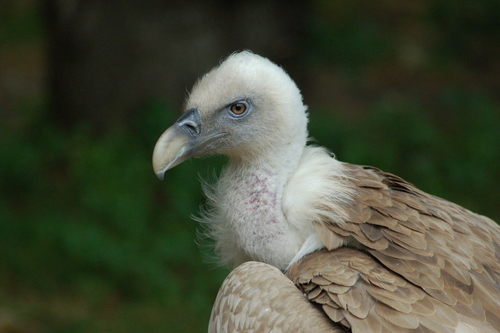
Griffon Vulture
The Griffon Vulture (*Gyps fulvus*) is a large Old World vulture, renowned for its impressive size and crucial role as a natural recycler. These birds are primarily scavengers, feeding on the carcasses of large mammals, which helps prevent the spread of disease and maintains ecosystem health. Griffon Vultures are highly social, often congregating in large numbers at feeding sites and nesting colonies. While not globally threatened, they face regional population declines due to various factors, making them a species of conservation concern in some areas. They hold cultural significance in some regions, often symbolizing death and rebirth.
93-122 cm
Length
230-280 cm
Wingspan
Least Concern
Conservation Status
Distribution
Griffon Vultures are found across Southern Europe, North Africa, the Middle East, and parts of Central Asia. They are largely non-migratory, although some populations, particularly juveniles, may disperse widely. Their altitudinal range extends from sea level to high mountain ranges, sometimes exceeding 3000 meters.
Lifespan
Up to 40 years in the wild, and potentially longer in captivity.
Griffon Vulture's Habitat
Habitat Types
Mountains, Steppes, Open grasslands, Semi-arid scrublands
Climate Zones
Temperate, Mediterranean, Arid
Adaptations
Griffon Vultures are well-adapted to soaring flight, utilizing thermals to conserve energy while searching for carrion. Their keen eyesight allows them to spot carcasses from great distances. They also possess a strong, hooked beak for tearing through tough hides.
Variations
Two subspecies are generally recognized: *Gyps f. fulvus* (Europe, North Africa, Middle East) and *Gyps f. fulvescens* (India, Pakistan, and parts of Central Asia). The latter is sometimes considered a separate species, the Himalayan Griffon (*Gyps himalayensis*), but further research is needed for confirmation.
Appearance
Breeding Plumage
Little difference between breeding and non-breeding plumage.
Seasonal Feather Changes
Minimal seasonal variation.
Sex Based Plumage Differences
Males and females have similar plumage.
Notable Features
Whitish head and neck with a ruff of white feathers., Buff-colored body plumage., Dark brown flight feathers., Powerful, hooked beak.
Diet and Feeding
Primary Foods
Carrion (dead animals), Large mammals (e.g., cattle, sheep, deer)
Foraging Behavior
Griffon Vultures primarily locate food by sight, soaring high above the ground and scanning for carcasses. They often rely on other scavengers, such as crows or jackals, to alert them to potential food sources. They feed in groups, often dominating carcasses due to their size.
Specializations
Their digestive system is highly resistant to bacterial toxins found in decaying flesh. Their relatively bare head and neck prevent feathers from becoming soiled with blood and tissue.
Seasonal Diet Variations
Dietary variations are primarily driven by the availability of carcasses, which can fluctuate seasonally due to factors like livestock management practices and wildlife mortality patterns.
Behavior
Social Structure
Highly social; form large colonies for nesting and roosting. Feeding aggregations can involve hundreds of birds.
Communication
Hissing and grunting sounds at carcasses., Visual displays, such as posture and wing movements., Chemical communication may play a role, but this is not fully understood.
Migration
Mostly resident, but some populations, especially young birds, may undertake long-distance dispersal movements.
Territorial or Group Behaviors
Nesting colonies are defended against intruders. At carcasses, a dominance hierarchy often exists, with larger individuals typically gaining better access to food.
Conservation
Threats
Poisoning (intentional or unintentional)., Collision with power lines., Habitat loss and degradation., Reduced food availability (due to changes in livestock management)., Disturbance at nesting sites.
Protection Programs
Monitoring of populations., Establishment of protected areas., Supplementary feeding programs (providing safe carcasses)., Public awareness campaigns., Regulation of the use of veterinary drugs (e.g., diclofenac).
Local National Laws
Protected under various national and international laws, including the EU Birds Directive.
Population Trend
Stable globally, but declining in some regions.
Population Estimates
Estimated global population is between 600,000 and 800,000 mature individuals.
Interesting Facts
They can consume up to 1 kg of meat in a single feeding.
This allows them to survive for extended periods without food.
Griffon Vultures have been recorded flying at altitudes of over 11,000 meters (36,000 feet).
This makes them one of the highest-flying bird species.
They have a specialized tongue.
With backward-facing barbs that helps them rasp meat from bones.
Faqs about Griffon Vulture
Are Griffon Vultures dangerous to humans?
No, Griffon Vultures are scavengers and pose no threat to humans. They play a vital role in preventing the spread of disease.
Why do vultures have bald heads?
A bald head helps prevent feathers from becoming soiled with blood and other fluids when feeding on carcasses. This reduces the risk of bacterial infections.
How can I help Griffon Vulture conservation?
Support organizations working to protect vultures and their habitats. Advocate for responsible livestock management practices and the ban of harmful veterinary drugs like diclofenac. Report any suspected cases of poisoning to the relevant authorities.
Copyright @ Nature Style Limited. All Rights Reserved.
 English
English